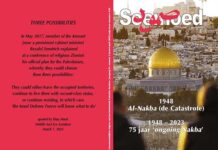Adam Raz
Haaretz / January 9, 2021
A person who violates a curfew shouldn’t be killed, but they can be slapped and hit with a rifle: Newly declassified documents reveal the ways military rule embittered the lives of Israeli Arabs [Palestinians].
The origins of the brutality documented in all its ugliness last week – an Israeli soldier shooting an unarmed Palestinian who was trying to protect the electric generator he needs to function, amid the abject poverty of the South Hebron Hills – date back quite a few decades, to the period of military rule in Israel proper. Testimony from recently declassified documents, together with historical records in archives, shed light on the acute violence that prevailed in the “state within a state” that Israel foisted upon extensive areas of the country where Arab citizens lived, from 1948 until 1966.
For more than 18 years, about 85 percent of the country’s Palestinian citizens were subject to an oppressive regime. Among other strictures, any movement outside their own villages had to be authorized, their communities were under permanent curfew, they were forbidden to relocate without formal approval, most political and civil organizing was prohibited, and entire regions where they had lived before 1948 were now closed to them. Although this part of the past has largely been repressed among most of Israel’s Jewish population, it constitutes an integral part of the identity and collective memory of the country’s Arab citizens. Those memories include, in addition to the regime of authorizations, daily abuse and a web of informants and collaborators.
In practice, for those subjected to the military government, Israeli democracy was substantively different than it was for the Jews. Yehoshua Palmon, Prime Minister David Ben-Gurion’s adviser on Arab affairs, wrote to the headquarters of the military government – in a letter from October 1950 culled from the State Archives – that reports had been received according to which military government personnel in the Triangle (a concentration of Arab communities adjacent to the Green Line, in the center of the country) were employing “illegal pressure during interrogations of residents, such as using dogs [against them], threats and the like.”
A year later, Baruch Yekutieli, Palmon’s deputy, explained to the cabinet secretary that the situation in the Arab areas sometimes required “a strong hand on the part of the authorities.” Although he did not go into detail about that policy, testimonies that have been made public describe its implementation – and all of them reflect an experience of humiliation and subjugation.
Thus, it became known that representatives of the military government threatened citizens so as to prevent them from complaining about actions taken against them; a military governor (there were three, for the Negev, the Triangle and the north) demanded that people frequenting a village café show their respect by standing up when he entered and threatened anyone who disobeyed; soldiers amused themselves when intimidating an Arab citizen by leaning on him by placing a firearm on his shoulder; and others prevented Muslim citizens from praying. In other cases, military government representatives harassed farmers and destroyed their property; people were humiliated regularly and addressed in coarse language; violence was perpetrated on children; and military government personnel made threats against Arab citizens if they didn’t vote in elections for the candidates favoured by the authorities.
The military governor in the south, Yehoshua Verbin, maintained in testimony he gave in early 1956 to a government committee – and recently made public at the request of the Akevot Institute for Israeli-Palestinian Conflict Research – that “the military government is too liberal and gentle. Let us not speak of cruelty at all, because that is groundless, it is a calumny for which there is no basis in any case.”
However, remarks by the governor of the Triangle, Zalman Mart, in his 1957 testimony in a trial relating to the Kafr Qasem massacre the previous year – when Border Police shot and killed 49 Arab villagers who were unaware that a curfew had been imposed – refute Verbin’s assertions. According to Mart, there was no obligation to kill a person who violated a curfew, but there was a sort of protocol for punishment: “You can slap him, hit him with a rifle on the leg, you can shout at him.”
A cluster of lengthy testimonies by Border Police personnel, who acted as the police force in the Arab villages, offers a picture of day-to-day life under the shadow of the military government. The officers’ unabashed candour in their testimony in the Kafr Qasem trial is harrowing. Were you “imbued with the feeling that the Arabs are the enemies of the State of Israel?” one officer was asked – to which he replied, simply, “Yes.” The police officer was asked, “Would you kill anyone? Even a woman, a child?” “Yes,” he reiterated. Another police officer testified that had he been ordered to do so, he would have opened fire at a bus packed with Arab women. And another explained, “I was always told that every Arab was an enemy of the state and a fifth column.”
The officers showed little sense of pity when asked about shooting helpless individuals, most of them affirming that they would do so if required. One of them noted that if he were to come across an infant who had “violated” curfew – “It might sound cruel, but I would shoot him. I would be obligated to do so.”
Some of the complaints made by the subjects of the military government were submitted anonymously. A report of the Jewish-Arab Association for Peace, sent in 1958 to a ministerial committee, opened by explaining the reasons for the anonymous charges: “In previous cases the military government apparatus employed threats and pressure against people [meaning Palestinian citizens of Israel] who gave testimony against it.” The association compiled a large number of accounts and appended the complainant’s name to each one, requesting that “the honourable ministers ensure that there be no such pressure and that people not be made to suffer because of their testimony.”
Several testimonies from the village of Jish (Gush Halav) dating from 1950, stored in the Yad Yaari Archive, shed light on what the military government tried to conceal. A local resident, Nama Antanas, related how its personnel had burst into his house in the middle of the night and taken him for an interrogation. Antanas was accused of buying a pair of smuggled shoes. The interrogators told him that if he wasn’t going to talk, they would see to it that he did. According to his testimony, “Amid this, I was ordered to take off my shoes and remove my head covering. When I did so, I was forced to sit on the floor and my legs were lifted and placed on a chair. At that moment, two soldiers approached me and started to beat me on the soles of my feet with a wooden stick made from the rough branch of a date tree.” Afterward, he was thrown out, unable to walk.
Another person, who was identified as al-Tafi, also related that security forces had burst into his house and beat him mercilessly. One military government official explained that they were going to execute him and ordered him into a car, as his wife stood by, distraught. After a short drive the car pulled over to the side of the road and a pistol was pressed against Al-Tafi’s head. After he was pummelled again and thrown into an animal pen, where, he said, he languished for two weeks.
Hana Yakub Jerassi was subjected to similar treatment, after the military governor told him he was “garbage.” He was beaten on his hands until they bled. “Afterward I was taken out and one of my friends was brought in, and they did the same to him as to me. Then a third was brought in and they did the same.”
For many, that was the routine.
The diverse sets of testimony we have uncovered compel us to doubt the words of Mishael Shaham, the commander of the military government between 1955 and 1960. In 1956 he told a government committee that was debating the future of that body that it was “not serious,” and that it even “constitutes an element for education to good citizenship.”
What’s clear is that the state took steps to conceal from the public information about what went on within the realm of the military government. In February 1951, then-Israel Defense Forces Chief of Staff Yigael Yadin was furious at the publication of a report about the expulsion of 13 Arab villagers from their villages. According to Yadin, “Reports of this sort are liable to be harmful to the state’s security, so a way needs to be found for the censorship to delay their publication.” The poet Natan Alterman knew what he was talking about when he wrote “Whisper a Secret,” a poem that criticized the tough censorship regime, a year later.
The military government apparatus was dismantled years ago, but its spirit lives on in Israel and outside it – in the occupied territories. Back then this apparatus supervised and ruled the country’s Palestinian citizens within the Green Line, whereas now policing actions are conducted by soldiers against a civilian population across the Green Line. And there is another similarity. Now, as then, the majority of the Israeli public lives with the wrongs being perpetrated and is silent.
Adam Raz is a researcher at the Akevot Institute for Israeli-Palestinian Conflict Research. This article is based upon the book “Military Rule, 1948-1966: A Collection of Documents,” published this month by Akevot












